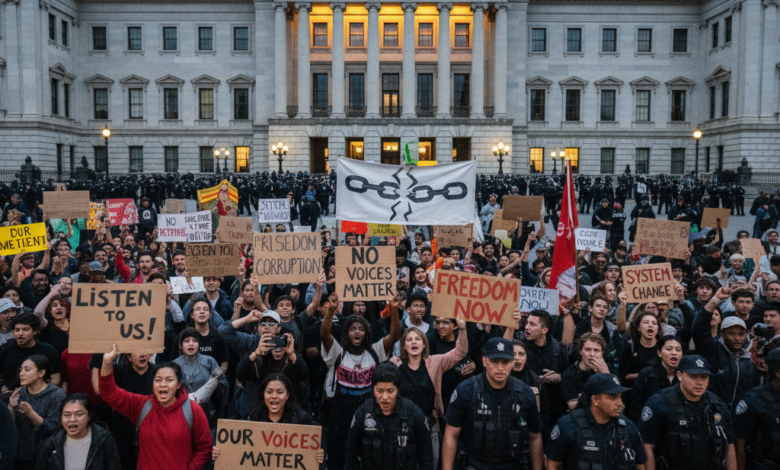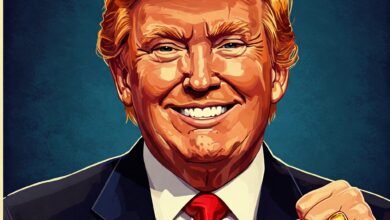Understanding Public Dissent: The Reasons Behind Protests Against Governments

Introduction to Public Dissent
Public dissent is a crucial aspect of democratic societies, serving as a fundamental mechanism through which citizens can express their discontent with governmental actions or policies. It encompasses a wide range of activities, including protests, demonstrations, and various forms of activism aimed at influencing political change. Historical contexts reveal that public dissent has been instrumental in shaping political landscapes, prompting legislative reforms and fostering greater accountability among governing bodies.
Throughout history, protests have arisen in response to social injustices, economic disparities, and political oppression. Notably, civil rights movements, anti-war demonstrations, and movements advocating for environmental sustainability exemplify how collective grievances can mobilize communities and challenge the status quo. These gatherings not only amplify individual voices but also create a collective identity among participants, reinforcing the notion that they are united in their pursuit of justice and reform.
The significance of public dissent extends beyond immediate political pressures. It reflects the health of a democracy, providing a means for marginalized groups to address grievances that may otherwise be overlooked. In many situations, the government’s response—or lack thereof—to protests can either strengthen or weaken public trust in its legitimacy. By facilitating dialogue between citizens and leaders, protests play a crucial role in fostering a responsive and accountable governance structure.
Public dissent acts as a barometer of public sentiment, informing policymakers about the issues that matter most to the populace. Understanding the multifaceted nature of public dissent is essential for recognizing its implications in shaping policies and societal frameworks. It is within this context that the role of protests as vital tools for advocacy must be acknowledged, as they contribute significantly to the democratic discourse and the ongoing pursuit of equity and representation.
Historical Context of Protests
Throughout history, protests have served as a powerful tool for expressing dissent against government actions and policies. The roots of such movements can often be traced back to significant social, political, and economic grievances. Notably, one of the earliest recorded instances of public dissent occurred during the American Revolution in the late 18th century. Citizens protested against British taxation without representation, ultimately leading to a pivotal change in governance and the establishment of a new nation.
Similarly, the French Revolution at the end of the 18th century was spurred by widespread discontent with social inequalities and the financial crisis, leading to the overthrow of the monarchy and the establishment of a republic. These events marked key moments in history that illustrated how the collective voice of the populace could challenge autocratic regimes. Their outcomes set the stage for future movements worldwide.
In the 20th century, the Civil Rights Movement in the United States emerged as a significant struggle against racial inequality and discrimination. Through peaceful protests, sit-ins, and marches, activists like Martin Luther King Jr. brought national attention to injustices faced by African Americans. The landmark events of this movement, including the March on Washington in 1963, not only highlighted the urgency of civil rights issues but also inspired subsequent protests globally, including the anti-apartheid movement in South Africa.
As we progressed into the 21st century, the dynamics of protests evolved owing to globalization and technological advancements. Events such as the Arab Spring illustrated how social media could amplify dissent and mobilize millions against entrenched governments. These historical examples demonstrate the continuous evolution of public dissent, showcasing how protests can arise from various circumstances, ultimately reflecting the complexities of human rights, governance, and societal change.
Factors Leading to Protests
Public dissent is often a response to a confluence of factors that evoke strong sentiments among individuals and groups. One of the primary drivers of protests is social injustice. When marginalized communities experience systematic discrimination or inequality, they often feel compelled to mobilize in order to demand equitable treatment. A notable example includes the Black Lives Matter movement, which arose in response to persistent racial inequality and police brutality, galvanizing thousands across the globe to advocate for justice.
Another significant factor contributing to public dissent is political corruption. When citizens perceive a lack of integrity or accountability from their leaders, it can lead to widespread outrage. For instance, the protests in Brazil in 2013 were largely fueled by discontent over government corruption and misuse of funds, prompting citizens to take to the streets to demand transparency and reform. Such actions illustrate the powerful link between perceived governmental misconduct and public mobilization.
Economic inequality also plays a crucial role in instigating protests. As wealth becomes increasingly concentrated among a small percentage of the population, those left behind may feel disenfranchised and voiceless. The Occupy Wall Street movement in the United States encapsulated this sentiment when protesters highlighted the disparity between the wealth of the 1% and the struggles faced by the remaining 99%. This grassroots uprising underscored how economic imbalance can serve as a catalyst for collective action.
Finally, human rights violations represent another critical factor leading to protests. When governments fail to uphold citizens’ rights, whether through oppressive laws or violent repression, public outcry is often inevitable. The Arab Spring serves as a poignant reminder, where demands for democratic reforms and the respect of human rights culminated in widespread protests across the Middle East.
These factors collectively illustrate the complexities of public dissent, where diverse motivations converge to inspire individuals to rise against perceived injustices and seek change.
The Role of Social Media in Modern Protests
In the digital age, social media has emerged as a powerful tool in the organization and dissemination of information regarding protests and dissent against governments. Platforms such as Twitter, Facebook, and Instagram facilitate the rapid sharing of messages, helping activists mobilize participants and amplify their calls for change. These resources have transformed how movements are conceived, organized, and executed, enabling unprecedented levels of engagement and outreach.
One notable example of social media’s impact can be observed in the Arab Spring, which began in late 2010. Activists used social media to document injustices, share real-time updates, and coordinate protests, contributing to the widespread uprisings across the Middle East and North Africa. The use of hashtags became instrumental, allowing for the consolidation of messages and making it easier for individuals to join these movements, significantly increasing visibility both locally and globally.
Similarly, the Black Lives Matter (BLM) movement in the United States demonstrated the capacity of social media to galvanize support for social justice initiatives. Following the tragic death of George Floyd in May 2020, activists leveraged platforms to organize protests, spread awareness, and share educational resources. The hashtag #BlackLivesMatter not only aided in unifying the cause but also attracted international attention, leading to solidarity marches across the world. Such examples indicate that social media serves both as an organizing tool and a pivotal space for dialogue surrounding issues of social injustice.
Additionally, social media provides a visual narrative by enabling the sharing of images and videos directly from the protest sites. This immediacy fosters a sense of urgency and solidarity, encouraging more individuals to participate or support similar causes. As a result, social media plays a crucial role in modern civic engagement, reshaping the landscape of public dissent and providing a platform where voices can be amplified and heard.
Psychological Aspects of Dissent
Public dissent often arises from complex psychological motivations that drive individuals to protest against their governments. Central to these reasons are factors such as identity, community belonging, and personal beliefs. When people identify strongly with particular groups or causes, their sense of self becomes intertwined with the collective identity of that group. These identities can serve as significant motivators for participation in protests, as individuals feel compelled to represent their communities and stand up for shared values and beliefs.
Moreover, a sense of community belonging plays a crucial role in the decision to engage in dissent. Individuals who feel connected to others within their community are more likely to participate in protests, as they experience a shared resolve and collective purpose. This social bond can amplify feelings of solidarity and support, making the idea of taking action against perceived injustices more compelling. The emotional reinforcement gained from belonging to a community can bolster individuals’ courage, encouraging them to join protests even in the face of potential repercussions.
In addition to identity and community factors, personal beliefs are a powerful motivator for public dissent. Individuals are driven by their moral or ethical convictions, systematically prompting them to take a stand against governmental policies they perceive as unjust. This intrinsic motivation is often influenced by life experiences, education, and social interactions. Furthermore, group dynamics can significantly impact individuals’ choices to participate in protests. The presence of a supportive group creates an environment where dissent becomes normalized, reducing the fear of social stigmatization and enhancing the willingness to engage in collective action.
Understanding these psychological aspects provides valuable insights into the motivations behind public dissent and the myriad factors that lead individuals to unite in protest against their governments.
Government Responses to Protests
Governments around the world adopt a variety of strategies when addressing public dissent, particularly during protests. The response to such civil unrest can be categorized mainly into peaceful negotiations and violent crackdowns. Each approach reflects the government’s attitude toward citizen grievances and influences the broader dynamics of civil society.
Negotiation is often the preferred method employed by governments when dealing with peaceful demonstrations. This approach usually involves dialogue with protest leaders, aiming to address the specific demands and concerns raised by the populace. By engaging in discussions, governments can foster an environment that promotes understanding and compromise. Interaction with protestors allows authorities to gather insights into the underlying issues causing unrest, paving the way for potential reforms. Successful negotiations can enhance state legitimacy and contribute to the overall stabilization of society.
On the other hand, some governments resort to violent crackdowns in an attempt to swiftly suppress dissent. This response often manifests in aggressive police action, including mass arrests, the use of tear gas, and even lethal force in extreme cases. While such repressive measures may temporarily quell protests, they frequently lead to increased public resentment and further unrest. The long-term consequences of violent government responses can undermine social trust and erode democratic institutions, as citizens become more wary of state actions.
Additionally, governments may implement a combination of these strategies depending on the nature of the protest and the political climate. While dialogue may be prioritized initially, a shift to repression may occur if protests escalate or if leaders perceive a threat to their authority. These varied approaches not only influence the immediate outcomes of protests but also set a precedent for future government interactions with civil society, shaping the landscape of public dissent for years to come.
Case Studies of Successful Protests
The landscape of political dissent has often been shaped by powerful protests that have led to notable reforms and societal change. Among the most significant examples are the Civil Rights Movement in the United States, the Arab Spring in the Middle East, and the Black Lives Matter movement. Each of these movements highlights the underlying motivations of public dissent and demonstrates the potential for sustained activism to foster political change.
The Civil Rights Movement, spanning the 1950s and 1960s, was a critical period for African Americans advocating for equality and justice. This movement succeeded through a combination of peaceful protests, legal challenges, and widespread advocacy, which ultimately led to landmark legislation such as the Civil Rights Act of 1964 and the Voting Rights Act of 1965. The strategic leadership of figures such as Dr. Martin Luther King Jr., the use of nonviolent resistance, and the ability to mobilize grassroots support were pivotal to its success. The movement not only transformed laws but also shifted societal attitudes towards race in America.
Similarly, the Arab Spring demonstrated the power of collective dissent in reshaping political landscapes across various nations. Beginning in late 2010, citizens across countries like Tunisia, Egypt, and Libya took to the streets to demand democracy, social justice, and an end to oppressive regimes. The rapid spread of social media played an essential role in organizing protests and amplifying voices of dissent, facilitating a new avenue for civic engagement that transcended traditional barriers. While the outcomes varied across different countries, the Arab Spring’s impact on democratic discourse in the region remains significant.
More recently, the Black Lives Matter movement emerged as a response to systemic racism and violence against Black individuals, particularly following high-profile police killings. This movement has effectively used both online platforms and public demonstrations to raise awareness and influence policy changes related to policing and racial equity. By fostering intersectional alliances and highlighting lived experiences of injustice, the movement has mobilized a wide demographic, resulting in impactful initiatives like local policy reforms and national discussions on race.
The Future of Public Dissent
As we look towards the future, it becomes increasingly clear that public dissent will continue to evolve in response to a myriad of social, political, and technological changes. One significant trend is the increasing influence of digital platforms in shaping dissent. As social media continues to permeate everyday life, it has become an essential tool for organizing protests, disseminating information, and mobilizing support. The ability to reach vast audiences instantaneously not only amplifies dissenting voices but also serves to create global communities around shared causes. This shift toward digital activism may result in more spontaneous and decentralized movements that challenge traditional structures of power.
However, this digital landscape presents new challenges for public dissenters. Governments are becoming more adept at monitoring online activities, raising concerns about surveillance and censorship. The tactics used to suppress dissent, including the use of misinformation and manipulation of social media platforms, may also become more sophisticated. In response, it is likely that activists will develop new strategies and tools to circumvent these challenges, adopting encrypted communication methods and utilizing decentralized networks that resist governmental control.
Moreover, the generational shifts in political engagement cannot be overlooked. Younger populations, increasingly informed by global issues and crises such as climate change, may push for more radical forms of dissent that prioritize immediate systemic change. The landscape of protest may also intersect with various social justice movements, reflecting a broader coalition of interests that seek to address intersectionality in their demands for change.
Thus, as technological advancements continue to reshape public discourse, the future of public dissent remains a dynamic and complex domain. It reflects a constantly changing interplay between authority and opposition, where traditional forms of protest coexist alongside emerging digital strategies, signaling a vibrant and enduring quest for justice.
Conclusion and Call to Action
Public dissent plays a crucial role in the functioning of democratic societies. The protests and movements witnessed across various nations often stem from deep-rooted issues, including social injustice, economic inequality, and political disenfranchisement. Understanding the motivations behind these dissenting voices is essential for fostering a more engaged and responsive civic environment. By acknowledging the reasons that propel individuals to protest, governments can better address the underlying concerns that fuel public unrest.
The dynamics between citizens and their governments become particularly pronounced in times of crisis. It is during these critical moments that the elements of public dissatisfaction manifest most clearly, urging the authorities to reflect on their policies and practices. Recognizing the significance of public dissent not only enhances the dialogue surrounding governance but also serves as a reminder of the power inherent in collective citizen action. This dialogue, when nurtured, can lead to more inclusive governance, ensuring that a wider spectrum of voices is heard and considered.
As members of a democratic society, it is essential for individuals to engage with civic issues actively. Participating in discussions, raising awareness about pressing matters, and advocating for change are vital actions that can contribute to a healthier political landscape. Citizens are encouraged to educate themselves on issues that matter, participate in community initiatives, and voice their opinions clearly and constructively. The strength of a democracy lies not only in institutions but equally in the commitment of its citizens to uphold the values of transparency, accountability, and justice.
In summary, understanding public dissent is not merely an academic exercise; it is an invitation to participate meaningfully in the democratic process. Let us reflect on our roles as citizens and commit to fostering a society where every voice counts, paving the way for a more just and equitable future.





















